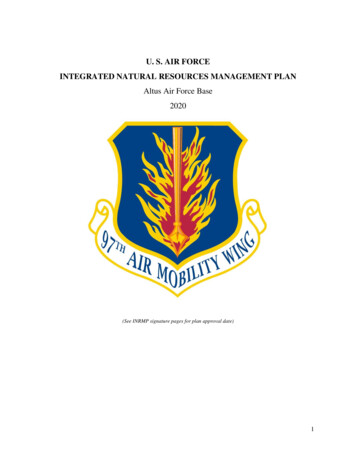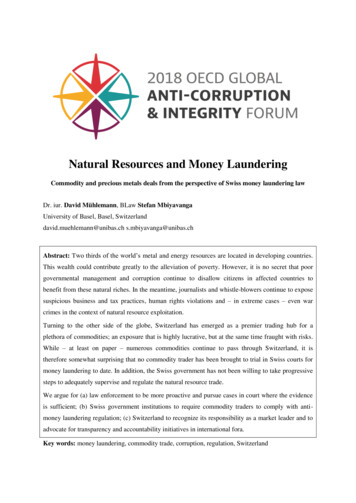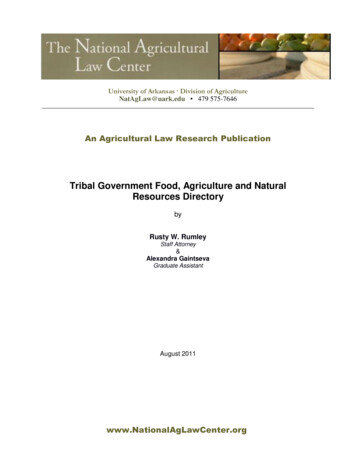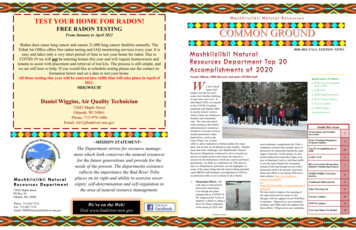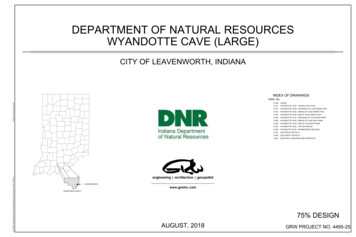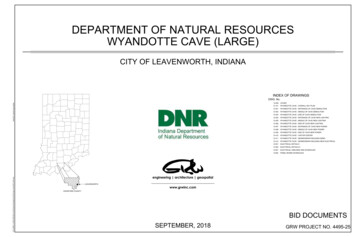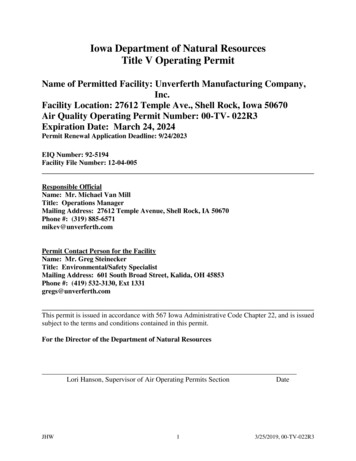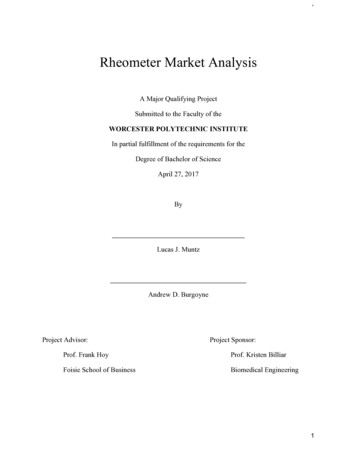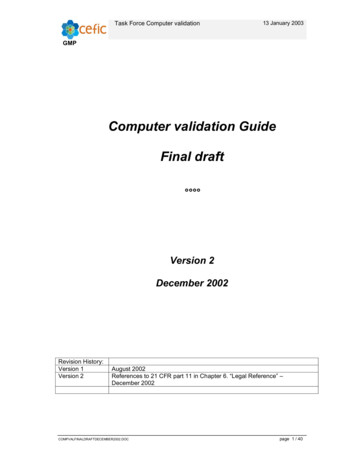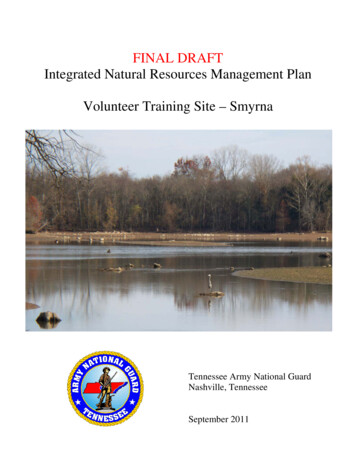
Transcription
FINAL DRAFTIntegrated Natural Resources Management PlanVolunteer Training Site – SmyrnaTennessee Army National GuardNashville, TennesseeSeptember 2011
Updated and Revised byJanie J. BeckerConservation BiologistBusiness World Management, Inc.AndLaura LecherNatural Resources ManagerTennessee Military DepartmentOriginally prepared for and submitted to theTennessee Military Department, Environmental OfficebyKristin M. SnyderPO Box 231213Anchorage, AK 99523
Volunteer Training Site – SmyrnaIntegrated Natural Resources Management PlanSignature PageThis Integrated Natural Resources Management Plan (INRMP) meets the requirements forINRMPs listed in the Sikes Act Improvement Amendments (16 U.S.C. 670a et seq.), AR 200-3,and the “Executive Summary and Scope” within this plan. It has set appropriate and adequateguidelines for conserving and protecting the natural resources of the Volunteer Training Site atSmyrna.APPROVING OFFICIALS:DATE:COL MICHAEL J. BENNETTChief Environmental Programs DivisionNational Guard BureauMG TERRY M. HASTONThe Adjutant GeneralTennessee National GuardCOL DARRELL DARNBUSHDeputy Chief of Staff, OperationsTennessee Army National GuardLTC GARY B. HERRTraining Site CommanderTennessee Army National GuardCOL STEPHEN B. LONDONEnvironmental Protection SpecialistTennessee Army National Guard
ACRONYMS AND EAir Force BaseAbove Mean Sea LevelArmy RegulationsAquatic Resource Alteration PermitArmy National GuardBest Management PracticeCouncil for Environmental QualityConstruction and Facilities Management OfficeDepartment of ArmyDepartment of DefenseDepartment of Defense InstructionEnvironmental AnalysisEnvironmental Management SystemEnvironmental Office (of the TNARNG)Executive OrderEnvironmental Protection AgencyEndangered Species ActFacilities Maintenance/Engineering Office (of the TNARNG)Forest Management PlanForward Operating BaseFinding of No Significant ImpactGeographic Information SystemGlobal Positioning SystemHeadquartersIntegrated Cultural Resources Management PlanIn-houseIntegrated Natural Resources Management PlanIntegrated Pest Management PlanInvasive Pest PlantInstallation Restoration ProgramInternational Standard OrganizationIntegrated Training Area ManagementLand Condition Trend Analysis (now RTLA)Mission Essential Task ListMemorandum of AgreementMilitary Occupational Skill QualificationMilitary PoliceNorth Carolina Vegetation SurveyNational Environmental Policy ActNational Guard BureauNational Guard Bureau – Director of Environmental ProgramsIntegrated Natural Resources Management PlanVTS-Smyrnai
USDIUSFWSUSGSVOCVTS-SWFMPNational Guard Bureau – Director of EngineeringNational Guard Bureau – Director of Operations, Training, and ReadinessNational Oceanic and Atmospheric AdministrationUnited States Natural Resources Conservation ServiceNational Register of Historic PlacesOperations and MaintenancePetroleum, Oil, and LubricantsPlans, Operations, and Training Officer (of the TNARNG)Projectile Point/KnivesRecord of Environmental ConsiderationRare, Threatened, or Endangered SpeciesSikes Act Improvement Act of 1997Species at RiskState Historic Preservation OfficeTraining Site personnel (of the TNARNG)Staff Judge AdvocateStreamside Management ZoneStandard Operating ProcedureSpill Prevention, Control, and CountermeasureStatus Tool for Environmental ProgramStorm Water Pollution Prevention PlanTraining AreaThe Adjutant GeneralTennessee Code AnnotatedTennessee Department of Environment and ConservationTennessee Air National GuardTennessee Army National GuardThe Nature ConservancyTennessee Division of natural HeritageTennessee Exotic Pest Plant CouncilTennessee Valley AuthorityTennessee Wildlife Resources AgencyUrban Assault CourseUnited States Air ForceUnited States Army Corps of Engineers Environmental Research LaboratoryUnited States Department of AgricultureUnited States Department of CommerceUnited States Department of the InteriorUnited States Fish and Wildlife ServiceUnited States Geologic ServiceVolatile Organic CompoundsVolunteer Training Site–SmyrnaWildland Fire Management PlanIntegrated Natural Resources Management PlaniiVTS-Smyrna
EXECUTIVE SUMMARYThis Revised Integrated Natural Resources Management Plan (INRMP), which is required by the SikesAct, as amended (16 U.S.C. 670a et seq.), has been developed for use by the Tennessee Army NationalGuard (TNARNG) to provide guidance on the protection of natural resources at the Volunteer TrainingSite – Smyrna (VTS-S). The original VTS-S INRMP was implemented in 2002. As the natural resourcesmanagement program developed, it was determined that the original INRMP format was not serviceable.Therefore, a revision of formatting and information was undertaken for this second iteration. Cooperatingagencies were contacted 2 June 2006 and informed of the TNARNG intent to revise the INRMP for theVTS-S (Appendix C). At this time, TNARNG requested input from both the United States Fish andWildlife Service (USFWS) state field office and from the Tennessee Wildlife Resources Agency(TWRA); no objections were raised from either organization toward the prospect of developing acomplete revision of the existing INRMP. Therefore, the formal “five year review for operation andeffect” was incorporated into the revision process.The primary purpose of natural resources management at VTS-S is to support the military trainingmission. The purpose of this INRMP is to ensure that natural resource conservation measures andmilitary activities on mission lands are integrated and consistent with responsible stewardship andenvironmental compliance. This INRMP was prepared in accordance with the Sikes Act, as amended;Army Regulation (AR) 200-1 – Environmental Protection and Enhancement; and Department of DefenseInstruction (DoDI) 4715.3 – Environmental Conservation Program.The National Environmental Policy Act (NEPA) of 1969 dictates that planners of public actions usingfederal monies, such as those on military installations, shall consider the environmental impacts andeffects of “major federal actions.” Section 1508.18 in the Council for Environmental Quality (CEQ)regulations lists the adoption of a formal Integrated Natural Resource Management Plan as a major federalaction. The NEPA for this document is being tiered off the Environmental Assessment for the firstaddition of the VTS-S INRMP. A Record of Environmental Consideration (REC) for this revised plan islocated in Appendix A. The Finding of No Significant Impact (FNSI) for the original EA can be found inAppendix B. In addition, in accordance with §670a(2) of the Sikes Act, approval of the INRMP has beennoted in writing by the U.S. Fish and Wildlife Service and the Tennessee Wildlife Resources Agency(Appendix C).The goals of this INRMP are: To describe the training site and its physical natural resources To describe the military mission, potential effects of the mission on natural resources at thetraining site, and options for resolving conflicts between the military mission and naturalresources management To show the status of baseline inventories of natural and cultural resources and monitoringrequirements for environmental compliance To present goals for the management of the site’s natural resources and tasks designed to achievethose goals. To recommend revegetation and erosion control techniques to maintain stable soils and ensurehigh-quality water resources and training opportunitiesIntegrated Natural Resources Management PlanVTS-Smyrnaiii
To provide management guidelines that will be effective in maintaining and improving thesustainability and biological diversity of terrestrial and wetland ecosystems on the training site,support human needs, emphasize public involvement, partnerships and adaptive managementBenefits to the military mission include improved maneuver lands and better distribution of militaryactivities at VTS-S. This plan will enhance mission realism through more options for training as well asmore intensive planning of missions. It will also enhance long-range planning efforts at VTS-S. Benefitsto the environment include reduced soil erosion and vegetation loss, improvement of water-quality inwetland and riparian ecosystems, and an increase in overall knowledge of the operation of the ecosystemson VTS-S through surveys and monitoring.This document begins with a description of the subjects: mission and facility details are outlined inChapter Two, while specifics of the physical environment at VTS-S are presented in Chapter Three.Chapter Four addresses the management goals for VTS-S according to the resource categories specifiedby the Sikes Act and the projects designed to meet those goals. Chapter Five presents guidelines intendedfor management and training activities as they relate to natural resources protection.The ten Appendices of this document contain supplemental material, including NEPA documentation,additional biological data, and records of the annual review process. Three detailed management plansare included as annexes to this document: the Forest Management Plan, Wildland Fire Management Plan,and the Invasive Pest Plant Control Plan. Additional management plan annexes may be developed forother activities as needed.Integrated Natural Resources Management PlanVTS-Smyrnaiv
Table of ContentsAcronyms and AbbreviationsExecutive SummaryTable of ContentsList of AppendicesList of Management Plan AnnexesList of TablesList of FiguresiiiivviiviiviiiviiiChapter 52626272727282929293030301.41.51.6Chapter 2.2.12.22.32.42.52.62.72.82.9Chapter 3.3.13.23.3General InformationPurposeManagement PhilosophyResponsibilities1.3.1 National Guard Bureau1.3.2 TNARNGRelevant Environmental RegulationsEnvironmental ReviewImplementation and Revision1.6.1 Personnel1.6.2 Outside Assistance1.6.3 Training1.6.4 Funding1.6.5 Priorities and SchedulingTraining Site OverviewLocation and Regional Character2.1.1 Location, Size, General Description2.1.2 Property Ownership2.1.3 Neighboring Land Ownership and Encroachment2.1.4 Demographics2.1.5 Nearby Natural AreasInstallation HistoryMilitary MissionFacilitiesTraining Site UtilizationEffects of Training on Natural ResourcesNatural Resources Needed to Support Military MissionNatural Resources Constraints Mission/Mission Planning2.8.1 Water Quality2.8.2 Noise and Encroachment Issues2.8.3 Invasive Species2.8.4 Forest ManagementGeographic Information System (GIS) AssetsPhysical and Biotic EnvironmentClimatePhysiography and TopographyGeology3.3.1 Geologic Formations3.3.2 SeismicityIntegrated Natural Resources Management PlanVTS-Smyrnav
3.3.3 Petroleum and Mineral Resources3.4 Soils3.4.1 Soil Descriptions3.4.2 Soil Erosion Potential3.4.3 Prime Farmland3.5 Water Resources3.5.1 Surface Water3.5.2 Ground Water3.5.3 Water Quality3.6 Wetlands3.6.1 Wetlands Vegetation3.6.2 Wetlands Inventory and Mapping3.7 Vegetation3.7.1 Vegetative Cover3.7.2 Forest Management3.7.3 Invasive Pest Plants3.8 Fish and Wildlife3.8.1 Migratory Birds3.8.2 Wildlife and Game Management3.9 Rare, Threatened, or Endangered Species3.9.1 Rare plant species at VTS-S3.9.2 Rare animal species at VTS-S3.10 Cultural Resources3.10.1 Palaeoenvironment3.10.2 Pre-European Populations3.10.3 Historic Overview3.10.4 Native American Resources3.10.5 Cultural Resources Identified on VTS-SChapter 4. Resource Management Goals4.1 Military Mission Goals and Objectives4.2 Natural Resources Goals and Objectives4.2.1 Ecosystem Management and Maintenance of Biodiversity4.2.2 RTE Management4.2.3 Reclamation/Mitigation4.2.4 Erosion Control and Soil Conservation4.2.5 Watershed Management4.2.6 Wetlands Protection4.2.7 Forest Management4.2.8 Fire Management4.2.9 Fish and Wildlife Management4.2.10 Pest Management4.2.11 Long-term Vegetation Monitoring4.2.12 Grounds Maintenance4.2.13 Recreational Use Management4.2.14 Environmental Hazards4.2.15 Cultural Resources Management4.2.16 Geographic Information Systems4.2.17 Environmental Management Systems4.3 Natural Resources Projects4.3.1 Survey History4.3.2 Implementation of INRMP 2001-2005Integrated Natural Resources Management 7676777878797980vi
4.3.3 Natural Resources Projects for Revised INRMPChapter 5. Resource Protection Guidelines5.1 Training Operations5.2 Construction5.3 Facilities Management5.4 Road Construction and Maintenance5.5 Water Resources5.6 Forestry and Forestland Use5.7 Grassland Use5.8 Pest Management5.9 RTE Monitoring and Protection5.10 Cultural Resources Management5.11 Management endicesA. Record of Environmental ConsiderationB. Finding of No Significant ImpactC. Agency CorrespondenceD. Public CommentE. Environmental RegulationsF. Species ListG. Descriptions of Natural Areas located within 15 miles of VTS-SH. American Indian TribesI. Pest Management Forms and GuidanceJ. Annual Review DocumentationManagement Plan Annexes1. Forest Management Plan2. Prescribed Fire Plan3. Invasive Pest Plant Control PlanIntegrated Natural Resources Management PlanVTS-Smyrnavii
List of Tables2.1 Selected demographic data for Rutherford County, Tennessee2.2 Current training area uses2.3 Training Site utilization, 2002-20062.4 Military training and land use activities that may cause soil orvegetation disturbance3.13.23.33.43.513192324Geologic formations of the Stones River GroupSoils types at VTS-SSoil erosion potentialForest product volume summaryRare plant and animal species found at or in the vicinity of VTS-S30333653574.1 Surveys conducted at VTS-S4.1 Project status from the 2002-2006 INRMP4.2 VTS-S natural resources projects7980825.1 Erosion control Best Management Practices (BMPs) for construction projects5.2 Forestry Best Management Practices5.3 Natural resources calendar899198List of Figures2.1 Location of VTS-Smyrna2.2 Local surroundings of VTS-Smyrna2.3 Aerial photograph of Sewart Air Force Base, 19632.4 VTS- Smyrna Training Areas and facilities2.5 Training man-days by user at VTS-S, FY 2002-20062.6 Monthly trends in total man-day usage at VTS-S, 39404250Topography of VTS-SmyrnaSoil types on VTS-SSoil erosion potential on VTS-SmyrnaStones River WatershedSurface water resources on the VTS-SFlooding on VTS-Smyrna on 4 May 2010Vegetation communities on VTS-SmyrnaIntegrated Natural Resources Management PlanVTS-Smyrnaviii
CHAPTER 1GENERAL INFORMATION1.1 PURPOSEThe Tennessee Army National Guard (TNARNG) maintains the Volunteer Training Site – Smyrna (VTSS) in Rutherford County, Tennessee, for the purpose of training Tennessee National Guardsmen. Thegoal of TNARNG land management on this training site is to ensure that there is no net loss of trainingland resulting from training activities. In addition, the TNARNG hopes to enhance training potential andenvironmental quality to the greatest extent possible through its management practices. This IntegratedNatural Resources Management Plan (INRMP) for VTS-S is the principle guiding document forTNARNG land management activities taking place on the training site. It is a revision of the originalVTS-S INRMP which covered the period 2001-2006, and will remain in effect until a revision is deemednecessary.The Sikes Act, Public Law 105-85, “Sikes Act Improvement Act of 1997,” (SAIA) November 18, 1997,requires the preparation of an INRMP for those military installations containing significant naturalresources and specifies the key information to be included in the Plan. The U.S. Fish and Wildlife Service(USFWS) and the Tennessee Wildlife Resources Agency (TWRA) are required to be cooperators in theprocess of developing the TNARNG INRMPs. The VTS-S contains 456 ac of forest land which may besubject to timber harvest through the DoD Forestry Reimbursable Program, as well as significant surfacewater resources as the training site abuts J. Percy Priest Lake and straddles one of the lake’s tributariesStewart Creek.The SAIA requires a review for operation and effect no less than every five years to keep the INRMPcurrent. Major changes require a revision be conducted while minor changes can be incorporated with anupdate to the existing INRMP. A revision or update will be used based on the review for operation andeffect conducted jointly with the USFWS and the TWRA. The original VTS-S INRMP was implementedin 2002. In years since, the mission requirements of the TNARNG have gradually shifted, creating theneed to alter some aspects of the training landscape at VTS-S. This change, in combination with theinitiation of a Forest Management Plan in 2004 and the unsatisfactory nature of the original INRMP,drove an internal decision by TNARNG in 2005 to initiate a full revision of the INRMP in coordinationwith the cooperating agencies. The cooperating agencies were contacted when the revision process wasbegun and did not object to a full revision, and they have contributed to the development of the newINRMP. Thus, the formal five-year review was conducted in conjunction with the revision process, andthe spirit of the interagency cooperative effort has been honored. Documentation of this cooperation isincluded in Appendix C.This Revised INRMP for VTS-S will serve to guide TNARNG activities on the training site until a reviewfinds that significant revision is necessary. The overriding goals of this plan are to minimize impact ontraining lands, to effectively repair damage caused by training activities, to improve the mission-specificqualities of the training lands, and to protect and enhance the ecosystem value of the training site. This isa living document which will be reviewed annually and updated as needed. Barring earlier need forsubstantial revision, five years following the date of implementation of this document, the USFWS,TWRA, and TNARNG will coordinate a review for operation and effect to determine whether the INRMPis functioning effectively or whether another large-scale revision is necessary.Natural resources management is an on-going, long-term process. This and subsequent iterations of theINRMP will serve to shape the direction of that process to support the military mission of the TNARNG,Integrated Natural Resources Management PlanVTS-Smyrna1
Chapter OneGeneral Informationto encourage sustainable management of natural resources, and to ensure compliance with all relevantfederal, state, and local laws.1.2 MANAGEMENT PHILOSOPHYAs stated above, the primary goal of land management at VTS-S is to meet military training needs, nowand in the future, while maintaining a healthy ecosystem. To ensure the ability to meet those futureneeds, there must be a healthy natural system in place across the training site. The goals of training andof environmental protection should not be seen as opposing. Rather, the one, a healthy environment,should support and enhance the other, training potential.Department of Defense (DoD) Instruction 4715.3 directs that DoD land management incorporateecosystem management, biodiversity conservation, and multiple use management. The basic principle ofecosystem management is to focus on the health of the total environment – ecosystem composition,structure, and function – rather than individual species. It is management driven by goals and designed tobe adaptable: monitoring of results should lead to changes in the process if desired outcomes are notachieved. Biodiversity is short for “biological diversity,” and it refers simply to the variety, distribution,and abundance of organisms in an ecosystem. Biodiversity is crucial to the stability and functioning of anecosystem.
4.2.4 Erosion Control and Soil Conservation 67 4.2.5 Watershed Management 68 4.2.6 Wetlands Protection 70 4.2.7 Forest Management 70 4.2.8 Fire Management 71 4.2.9 Fish and Wildlife
